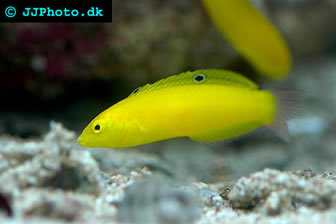Wrasse
The wrasses are marine fishes belonging to the family Labridae. This family contains about 500 different species divided into 60 genera. Many of the species are brightly coloured and some of them are kept in aquariums, particularly the species of the genus Coris. Some of the smaller wrasses are considered reef safe.
A few examples of wrasses that have been successfully kept in aquariums are Christmas Wrasse (Halichoeres ornatissimus), Dotted wrasse (Cirrhilabrus punctatus), Hawaiian Cleaner Wrasse (Labroides phthirophagus), Sharpnose wrasse (Wetmorella nigropinnata)
and Yellowhead wrasse (Halichoeres garnoti).
Wrasses are popular food fishes in many parts of the world and they are also appreciated by sport fishers. The tautog (Tautoga onitis) is known for being a true challenge to catch, partly because it lives among rocks and wrecks where the line can get snagged easily.
Distribution and habitat
Wrasses are found in the Atlantic Ocean, Pacific Ocean and Indian Ocean. They stay in the ocean and are not known to venture into brackish environments. Wrasses will typically inhabit shallow habitats such as rocky shores, coral reefs and wrecks where they stay close to the substrate. Many species like to burrow themselves in sand.
Anatomy
The largest species can be up to 230 cm (7.5 feet) long, but many species never exceed 15 cm (6 inches) in length. The shortest species stay around 4.5 cm (1.8 inches).
Wrasses have protractile mouths and many species have separate jaw teeth that project outwards. Gaps between the teeth are common. In the genus Gomphosus, the snout is elongated.
The body is covered in cycloid scales. As mentioned above, wrasses tend to be brightly coloured. Most species will change colour as they grow older and many species are capable of changing sex as they mature. During the initial phase, the juveniles are a mix of males and females. During the terminal phase, the largest adults claim a territory and become males. The males are typically more brilliantly coloured than the females.
Feeding wrasses
Wrasses are carnivores that chiefly feed on benthic invertebrates, but some are fond of plankton as well.
Some species enters symbiotic relationships with larger fish and remove ectoparasites from them without being injured. Such species will form “wrasse cleaning stations” and larger fish infested with ectoparasites will arrive to be cleaned. The larger fish will stay near the cleaning station with its mouth open while the wrasses carefully remove and devour parasites from the mouth, gill cavities and other surfaces. The wrasses will also remove dead tissue and scales. Some wrasses will “cheat” and eat healthy tissue and mucus as well. Some species of wrasse will visit individual fishes and clean them instead of setting up cleaning stations. This is believed to be away of benefiting from fish that is too territorial or too shy to visit a cleaning station.
Breeding wrasses
Wrasses are egg-laying, non-guarding fish. One male will mate with several females. All the species living in the Indo-Pacific region are pelagic spawners.
Wrasse Articles:
Bird Wrasse – Gomphosus varius
Dragon Wrasse - Novaculichthys taeniourus
Harliquin Tuskfish – Coerodon fasciatus
Hogfish - Information about Hogfish
Neon Wrasse – Halichoeres melanurus
Ornate Wrasse – Halichoeres ornatissimus
Queen Coris – Coris frerei
Radient Wrasse – Halichoeres iridis
Spanish Hogfish – Bodianus rufus
Striated Wrasse – Pseudocheilinus evanidus
Yellow Coris – Halichoeres chrysus
Line Wrasses:
Fourline Wrasse – Pseudocheilinus tetrataenia
Sixline Wrasse – Pseudocheilinus hexataenia
Eightline Wrasse – Pseudocheilinus octotaenia
Fairy Wrasses:
Exquisite Fairy Wrasse – Cirrhilabrus exquisitus
Lubbock's Fairy Wrasse – Cirrhilabrus lubbocki
Scott's Fairy Wrasse – Cirrhilabrus scottorum
Solar Fairy Wrasse – Cirrhilabrus solorensis
Flasher Wrasses:
Carpenter's Flasher Wrasse – Paracheilinus carpenteri
Dot-and-Dash Flasher Wrasse – Paracheilinus lineopunctatus
Filamented Flasher Wrasse – Paracheilinus filamentosus
McCosker's Flasher Wrasse – Paracheilinus mccoskeri
Anthias
Aquarium Chillers
Basses
Batfish
Blennies
Butterflyfish
Cardinalfish
Clown fish
Corals
Damselfish
Files
Goatfish
Gobies
Gorgonians
Grammas
Groupers
Grunts
Hawkfish
Jawfish
Jellyfish
Lionfish
Dragonets
Mantis shrimp
Marine angelfish
Marine Catfish
Moray eels
Nudibranch
Octopus
Pipefish
Protein skimmers
Pufferfish
Rabbitfish
Rays
Snappers
Scorpionfish
Sea Anemones
Sea horses
Sea Stars
Shark Fish
Shrimps
Snails
Squirellfish
Surgeonfish
Triggerfish
Wrasses

